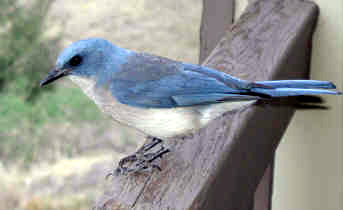Mexican Jay (Aphelocoma ultramarina) - wiki Mexican Jay
From Wikipedia, the free encyclopedia
[Photo] Mexican Jay from Texas, Aphelocoma ultramarina couchii. Note unmarked throat. Source: US NPS photo.
The Mexican Jay, Aphelocoma ultramarina, formerly known as the Gray-breasted Jay, is a New World scrub-jay native to the Sierra Madre Oriental, Sierra Madre Occidental, and Transvolcanic Belt of Mexico. It reaches north to southeast Arizona, southwest New Mexico and westernmost Texas in the United States. Its preferred habitat is montane pine-oak forest.
It is a medium-large passerine similar in size to most other jays, with a blue head, blue-gray mantle, blue wings and tail, and pale gray breast and underparts. The sexes are morphologically identical, and juveniles differ only in having less blue coloration and, in some populations, a yellow (instead of black) bill that progressively becomes more black with age. The iris is brown and legs are black. It is most readily distinguished from the similar Western Scrub-jay by the plain (unstreaked) throat and breast, and the mantle contrasting less with the head and wings. Its range somewhat overlaps with the Western Scrub-Jays, but, where they co-occur, the two species seem to show ecological and morphological character displacement (Curry et al. 2002).
In the winter, the Mexican Jay's diet consists mainly of acorns and pine nuts, which are stored in the autumn. However, they are ominvorous in all seasons and their diet includes a wide variety of plant and animal matter, including invertebrates, small amphibians and reptiles, and birds' eggs and nestlings.
It has a cooperative breeding system similar to that of the related Florida Scrub-Jay, with several birds helping at a nest; these 'helpers' are usually immature offspring of the dominant pair from the previous 1-2 years, but also include apparently unrelated flock members.
Systematics
There are seven described subspecies that are divided into three main groups (see below). Marked differences in size, color, vocalizations, and genetics have led some authors to consider these groups as separate species (Navarro-Sig??enza and Peterson 2004), but the geographic limits of these putative species are poorly described. Northern populations occupy a continuous, U-shaped area throughout the highlands of the Sierra Madres Occidental and Oriental, and might intergrade on the Mexican plateau. The southern range is throughout the Trans-Mexican volcanic belt. This forms an east-west line with no gene flow between it and the U due to the intervening Balsas Depression. Size variation does not always follow Bergman's Rule with more southerly populations in the Sierra Madre Oriental being larger than populations to the north. Also, the most southerly group in the Transvolcanic Belt is the largest of all. Color variation is apparent in that jays from the Transvolcanic Belt are more blue than populations to the north. Mexican jays do not seem to follow Gloger's Rule as Mexican jays in arid habitat in southwestern Texas are also some of the bluest. On the other hand, Mexican jays in Arizona - also arid habitat - have a washed-out appearance, in accordance with Gloger's Rule.
Southern group
Transvolcanic Belt of central Mexico. Juveniles have a yellow base to the beak into their second year. Adults are larger and longer-tailed but shorter-billed than those in the northern groups. Geographically isolated and morphologically and genetically distinct from northern groups. Differences between eastern (A. u. colimae) and western subspecies (A. u. ultramarina) deserve further study.
Aphelocoma ultramarina ultramarina Bonaparte, 1825
Trans-Mexican volcanic belt from SE Jalisco/NW Michoacan to central-west Veracruz, Mexico.
Aphelocoma ultramarina colimae
NW of ultramarina, but very local: west and central Jalisco to NE Colima
Western group
Sierra Madre Occidental to Arizona and New Mexico. Limits in Jalisco deserve further study. Juveniles have a yellow base to the beak for up to two years.
Aphelocoma ultramarina gracilis
E Nayarit and N Jalisco
Small
Aphelocoma ultramarina wollweberi
W Mexico
Intermediate
Aphelocoma ultramarina arizonae
NW Mexico north to Arizona and New Mexico, USA
Large. Uniformly pale green eggs without speckles.
Eastern group
Sierra Madre Oriental north to Texas. Juveniles have an all-black exterior to the bill after fledging, but roof of inner upper mandible can remain partially white for up to two years. Reports of less social behavior compared to other groups are over-stated and credible accounts of cooperative breeding (Ligon and Husar 1974) and large flocks sizes (Bhagabati and Horvath 2006) exist.
Aphelocoma ultramarina potosina
East-central Mexico
Larger
Aphelocoma ultramarina couchii
S Nuevo Le??n and W Tamaulipas north to SW Texas (Chisos Mountains)
Smaller than preceding. Population of latter species distinguishable by more contrasting markings and ecological preferences (lowland birds). Egg color may range from plain blue to nile blue with pale brownish speckling, most heavy on blunt half. Gives rattle call similar to Cyanocitta and Western Scrub-jays.
Etymology
Aphelocoma, from Latinized Ancient Greek aphelo-, "soft" (Ancient Greek: apalos, απαλ????) + Latin coma "hair", in reference to the smooth plumage of birds of this genus compared to other corvids. ultramarina, New Latin: "colored ultramarine blue".
http://en.wikipedia.org/wiki/Mexican_Jay
| The text in this page is based on the copyrighted Wikipedia article shown in above URL. It is used under the GNU Free Documentation License. You may redistribute it, verbatim or modified, providing that you comply with the terms of the GFDL. |
